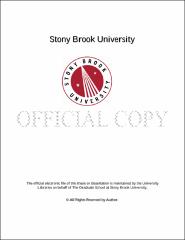| dc.identifier.uri | http://hdl.handle.net/11401/76299 | |
| dc.description.sponsorship | This work is sponsored by the Stony Brook University Graduate School in compliance with the requirements for completion of degree. | en_US |
| dc.format | Monograph | |
| dc.format.medium | Electronic Resource | en_US |
| dc.language.iso | en_US | |
| dc.publisher | The Graduate School, Stony Brook University: Stony Brook, NY. | |
| dc.type | Dissertation | |
| dcterms.abstract | One- and two-dimensional (1-D and 2-D) nanomaterials possess extraordinary physiochemical properties such as large surface area, excellent mechanical properties, high surface energy and good dispersivity in organic and biological solvents, therefore, they have been extensively used as reinforcing agents to improve the mechanical properties of polymeric scaffolds for bone tissue engineering applications. Carbon nanomaterials such as carbon nanotubes and graphene have been used as reinforcing agents for biodegradable polymeric scaffolds and composites, however, their short- and long-term in vitro cytotoxicity and in vivo biocompatibility is an area of extensive debate. In this study, we have systematically investigated the effects of addition of low concentrations (0.01-0.2 wt. %) of 1-D and 2-D carbon nanomaterials (graphene oxide nanoplatelets, graphene oxide nanoribbons and carbon nanotubes) and inorganic nanomaterials (boron nitride nanotubes, boron nitride nanoplatelers, tungsten disulfide nanotubes and molybdenum disulfide nanoplatelets) on the mechanical properties, cytocompatibility, and bioactivity of poly(propylene fumarate) (PPF) nanocomposites towards their potential applications as porous and nonporous implants for bone tissue engineering. Addition of nanomaterials in the PPF matrix improved the compressive and flexural mechanical properties of non-porous crosslinked PPF nanocomposites and porous PPF scaffolds. Our results suggest that in addition to high surface roughness and surface area of the nanomaterials, the presence of functional groups on the surface of nanomaterials leads to an increased nanomaterial-polymer interaction and a uniform dispersion of nanomaterials in polymer matrix which may be the key factors responsible for an improved mechanical reinforcement. The in vitro studies showed an excellent cytocompatibility for both carbon and inorganic nanomaterial reinforced PPF nanocomposites and scaffolds. Protein adsorption studies and in vitro osteogenic differentiation studies also showed that addition of these 1-D and 2-D carbon and inorganic nanomaterials leads to an improved protein adsorption that promotes osteogenic differentiation and calcium mineralization in vitro. and good cytocompatibility of PPF nanocomposites. The long term implication of this research focuses on the development of mechanically strong, biocompatible, biodegradable and bioactive nanocomposites that can potentially replace commercial bone grafts that often lack the required mechanical properties for load bearing bone tissue engineering applications. | |
| dcterms.available | 2017-09-20T16:49:59Z | |
| dcterms.contributor | Sitharaman, Balaji | en_US |
| dcterms.contributor | Meng, Yizhi | en_US |
| dcterms.contributor | Venkatesh, T. A. | en_US |
| dcterms.contributor | Simonsen, John. | en_US |
| dcterms.creator | Farrshid, Behzad | |
| dcterms.dateAccepted | 2017-09-20T16:49:59Z | |
| dcterms.dateSubmitted | 2017-09-20T16:49:59Z | |
| dcterms.description | Department of Materials Science and Engineering. | en_US |
| dcterms.extent | 230 pg. | en_US |
| dcterms.format | Monograph | |
| dcterms.format | Application/PDF | en_US |
| dcterms.identifier | http://hdl.handle.net/11401/76299 | |
| dcterms.issued | 2015-12-01 | |
| dcterms.language | en_US | |
| dcterms.provenance | Made available in DSpace on 2017-09-20T16:49:59Z (GMT). No. of bitstreams: 1
Farrshid_grad.sunysb_0771E_12458.pdf: 9506193 bytes, checksum: 3b4c8a179ee8e6e13ca418348434846d (MD5)
Previous issue date: 1 | en |
| dcterms.publisher | The Graduate School, Stony Brook University: Stony Brook, NY. | |
| dcterms.subject | Materials Science | |
| dcterms.subject | 1D & 2D, Biodegradable, Bone graft, Bone Tissue Engineering, Implants, Nanocomposite | |
| dcterms.title | Towards application of one- and two-dimensional nanomaterials for reinforcement of polymeric nanocomposite bone grafts | |
| dcterms.type | Dissertation | |

